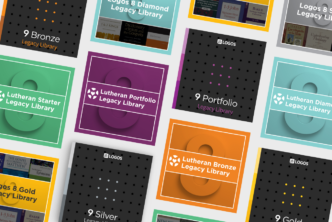You wouldn’t know just by looking at it, but Logos 6 represents a giant leap forward for Logos Bible Software.
When we sat down to design Logos 6, we wanted it to be the same, but different.
It’s always important in design to maintain a balanced tension between familiarity and surprise. Too much familiarity, and a new design is underwhelming (“Ho hum. So what?”). Too much surprise, and it becomes inscrutable and off-putting (“That’s bizarre—kill it with fire!”).
So no, the interface hasn’t changed much, except that it’s more polished. No, the feature set hasn’t been radically altered. Logos is still built on the foundation of a large library of resources, with guides to mine those resources for information, and new tools to act on it. Search is still search, only better. Way better.
Yet Logos 6 is very different from past versions—not so much in how it does, but what it does. When we started deciding the feature list for Logos 6, we asked two questions:
- What are people doing with Logos?
- What aren’t people doing with Logos?
Find me something to read
We know pretty well what people are doing with it: Bible study—that is, a certain kind of self-guided textual research that primarily answers the question What do I need to read?
That’s what Logos Bible Software has been about since the very first version: find all the stuff you need to read or watch in order to understand and interpret some passage or idea.
The large-library concept is an obvious application of this premise. So is the homepage, and all the guides, and most of the tools and documents. Notes, clippings, highlights, passage lists, word lists, reading plans, and even sentence diagrams—they’re all just different ways to capture what you’ve read and what you think about it. Datasets like Biblical People and the Bible Sense Lexicon are, when you boil it down, more new exciting things to read.
So we’ve got that base covered.
I’ve read everything—now what?
After talking to users one-on-one and in the forums, we heard a common theme emerge: Logos is a fantastic tool for study, but studying is a means to an end, not just an end unto itself.
As it happens, most people are not digging through all these books to find nuggets of wisdom to hoard them for themselves, but to “spend” them on making something for others—a sermon, a lesson, an article, a paper, a blog post, or an email to a friend in need. It’s kind of beautiful when you think about it. Logos Bible Software delivers its treasure up to the user, who in turn multiplies it by giving it away to others.
That’s what the Logos 6 theme “delivering insight” is really all about.
Yet, Logos 1–5 only addressed one side of the “delivering insight” coin. They’re great at delivering insight to you, the person on the other side of the screen, but they don’t offer much in the way of tools and resources to help you deliver that insight to others.
We talked to one youth pastor in particular who said he used Logos Monday through Friday, then he spent his Saturday looking for visual aids online to spice up his slide show. That is, he was throwing every search term he could think of at what he called the “World Wild Web” and hoping for the best.
Enter Logos 6
We realized that a lot of what people need is to communicate what they’ve learned. They need to present it. So, building on our foundation of a library of resources, we designed the following brand-new tools to address that need:
- Visual Copy: You’ve found the perfect quote that illustrates the exact idea you want to convey. You select it and copy it. Visual Copy gives you a place to paste it: a library of slide templates, specially selected to surgically target exactly what you’ve copied. No more fiddling around within presentation programs, and no more searching the Internet for a vivid and compelling rendering of that perfect quote (or one like it).
- Media Search: Logos 5 introduced Image Search, which was a huge hit. Logos 6 extends that functionality to include maps, charts, videos, and audio clips. But what’s more, it also finds slides made by the Logos’ professional design team, as well as some hand-picked images from the web.
- Interactive Media: Imagine a textbook with a few illustrations inside. Now imagine those illustrations can be manipulated and come to life. And further, that it’s not just one illustration of one example, but of lots of examples. We think these will be useful tools for learning and teaching, either one-on-one or in a classroom setting.
Logos 6 is the biggest release we’ve ever made: here’s a list of 44 new features, 16 updated features, 37 new exclusive resources, 10 new Media Collections, 16 new datasets, and 12 updated datasets.
But time’s running out to save on a new Logos 6 base package: discounts and introductory gifts disappear at 11:59 p.m. (PST) on February 2.
Don’t wait: get Logos 6 today!





